130.
Chapter 2: God Math (LOGOS, Logik, P=NP)
131.
God Math starts with two opposite limits and the midpoint between them. Those two opposites are known to humans now as “infinity” and “zero.” Fascinating concepts in and of themselves, it took a global culture to bring the two together and one writer (ed. Howdy!) to figure out how they can be used to explain a whole lot more than everything and nothing.
132.
I should be very clear to note here, this is my approach to “math” (with a bit of help). I made this stuff up because the math I was being taught in college didn’t apply to the real world as I saw it. I needed a better way to calculate anything easily. Calculus didn’t cut it for me.
133.
Part of my problem with Calculus was a professor who went by the name Dr. H at Trinity University in San Antonio, Texas, which is where I was formally edumacated. I’ve got the $100K piece of paper to prove it, and that piece of paper has already paid for itself many times over, and I’m yet a young man as of this typing. Dr. H hailed from India, and had the accent to prove it. It was my unfortunate inability to decipher his lectures, along with various social concerns, which ultimately ended my relationship with formal mathematical education.
134.
Hence, I hope you can understand why I ask forgiveness of the various folks in the reading audience who will find my treatment of infinity and zero to be damn near heretical. Check that, what follows is absolutely and completely mathematically heretical. This is my P=NP proof, after all. One would have to be a bit outside the norm to put forth such a concept in public, and so I’m applying for that position. I don’t think it leads to tenure.
135.
I needed a system of math that could be universally applied, easily calculated, be massively adaptable, easy to teach and learn, and you needed to be able to do it in your head. Calculus just wasn’t it for me. So I had to make up my own thing. It ultimately took nearly ten years of study and practice and thinking and searching and asking and praying and hoping and hurting to get to where I ended up.
136.
I ended up at a place where the voice finally said, “Yes, that’s right. Now go tell them about it.”
137.
138.
ZERO and The Model™ [NP]
139.
A great many great mathematicians hail from India, much like Dr. H-the-Un-Understandable. One of the more recent (in math years) was Subrahmanyan Chandrasekhar, who figured out how much matter, in how much space, would lead to a collapse of that section of the universe. This is now known as the Chandrasekhar Limit. A quick public knowledge definition follows…
140.
Via the Wikipedia: “Stars with higher mass [than the C-Limit] will develop a degenerate core whose mass will grow until it exceeds the limit. At this point the star will explode in a core-collapse supernova, leaving behind either a neutron star or a black hole”
141.
In my humble opinion, it is the black hole that defines what one could consider the “edges” of the Universe. A true edge to something is a place from which you cannot return. Once you cross what is called the “event horizon” of a black hole there is no turning back to the Universe you knew before. The universe as we know it is flat, and Newton’s Laws apply is this very real sense, an object once in motion will travel in a straight and continuous line until affected by another force forever. When it finally is affected it will react in exact proportion to that force. We later learned from Einstein that the existence of matter and energy made a lot of these “forces” universal, and indeed there exists a universal constant that turns straight, infinite lines into a fictional concept. There is no escape from the Force. This is why straight lines, perfectly straight lines that go on forever, are so rare as to be nearly unique in nature. The only one I’ve ever seen has been in my mind.
142.
However, there is a limit to those forces mentioned above, and we also know thanks to Chandrasekhar, and Darth Vader, that the force can eat itself. The ego can consume the soul. The black hole lets nothing escape, and as such is about the only stark “edge” one will ever find in the vast reaches of space.
143.
Zero is NP in my proof. It is the “anti-prpposition” or the “wrong answer” or the “limit to the set of all wrong answers.” Zero is the Dark Tower. Death.
144.
I’ll be coming back to this black hole metaphor later as I demonstrate one of the ways that The Model ™ can be applied. By The Model™ I am referring to the mathematical system I created over the roughly ten year period mentioned earlier. Understanding TM begins with an understanding of zero and infinity and their intimate relationship to the rest of rest of reality. I found it logical that a system which could be universally applied needed to have both the largest and smallest possible limits. Zero and Infinity qualified nicely.
145.
The “zero” of which I speak was the one defined by another Indian by the name of Brahmagupta in the year 628. His work “Brahmasputha Siddhanta” (The Opening of the Universe) defined the rules for using zero as follows…
146.
147.
148. - The sum of zero and a negative number is negative.
149. - The sum of zero and a positive number is positive.
150. - The sum of zero and zero is zero.
151. - The sum of a positive and a negative is their difference; or, if they are equal, zero.
152. - A positive or negative number when divided by zero is a fraction with the zero as denominator.
153. - Zero divided by a negative or positive number is either zero or is expressed as a fraction with zero as numerator and the finite quantity as denominator.
154. - Zero divided by zero is zero.
155.
156.
All but one of these rules is still in effect, as it were, in this modern age. The only one we have “improved” upon is the one about dividing by zero. We have since decided that this mathematical operation was “undefined”.
157.
This was one of the things about higher math that had bothered me for a long time. How could one of the most important and absolute limits of numbers not be used to divide?
158.
The solution that Brahmagupta missed had been present in Indian mathematical thought for nearly a thousand years. Sadly, infinity and zero weren’t really compared until it had been absolutely established that one could not divide by zero.
159.
We settled on rules that said if one tried to divide by zero, one was left with a non-answer, wandering in the mathematical wasteland forever. This disturbed me greatly, as I had been instilled as a younger man with a great desire to know the truth of all things and a great confidence that I could re-solve any problem. After all, the Voice had never steered me wrong, as it so quietly reminded me, shining brightly from above.
160.
Then one day, about midway through my twenty-second trip around the Sun, as my formal education neared an end, the answer came to me. I described it then like a bolt of lightning, and it set my soul afire. I had figured it out. I knew what was halfway between infinity and zero. What was precisely and provably halfway between everything and nothing. I had learned to divide by zero.
161.
162.
INFINITY and The Model ™ [P]
163.
What followed after that day was a flurry of activity. I had resolved one of the great mysteries left to figure out, and the answer fit perfectly. It was applicable to any number of things, and I saw the great potential that could come from my discovery. I wrote up a hasty explanation, breathlessly mailed out copies to every major news outlet and waited for the responses to come. I was careful to be what I thought was engagingly cryptic and looking back now, I laugh heartily at what I thought was good work then. When I look back at this work sometime in the future, I hope to receive a similar jolt of mirth.
164.
It wasn’t until years later that I realized what I thought was a new and novel concept had been discovered, analyzed and formalized in the 19th century by Bernhard Riemann, in what is affectionately known as Riemann’s Sphere.
165.
It took quite a few more years before I realized I might have just solved one of the most difficult equations in math. Or, more accurately, “math” itself.
166.
Infinity is P in my proof. It is the “proposition” or the “right answer” or the “limit to the set of all right answers.” Infinity is the Light Tower. God.
167.
I think I mention somewhere in this book exactly how it is that P = NP and how P ≠ NP [Appendix P=NP]. It really depends on how you define terms, and “math”. The missing element to finalize the equation is that One Unanswered Question, which is always swirling around, that extra dimension of analysis that often makes the question moot. Is P equal to NP? The correct clarifying question is, “When and Where?” or simply “In time/space?” If one is limited to answering the questions on our plane of existence, then one must have at least four dimensions to describe it, accurately. A proof then is somewhat trivial, as time becomes a finite property. “Pragmatic Infinity” replaces “Fictional Infinity” and solutions abound.
168.
The concept of Infinity itself had been around since being recorded in India (again) around the 4th century B.C. If was formalized and given the familiar symbol ∞ in 1655 by John Wallis in England. One of the many plunders of the English from the Indians (not quite as bad as Americans taking the whole concept of “Indian” and misapplying it), infinity has been in common if not problematic usage in a number of fields since it became more formalized [citation needed].
169.
We’ll get back to the whole sphere thing in moment, but right now I want to get back to that dividing-by-zero concept. What I had learned was that when you asked the question “what is infinity divided by zero”, the answer is in fact, “one.”
170.
This follows quite logically from the well accepted equation (one divided by infinity equals zero. This is generally applied to any finite number, X, in the equation ). However, the concept that no number could be divided by zero was so ingrained into the minds of so many that it wasn’t understood that accepting that (one divided by infinity equals zero) automatically implies the two following equations be true, (zero multiplied by infinity equals one) and the kicker (infinity divided by zero equals one [P/NP = 1, P=NP]).
171.
I know it might seem strange to many that figuring out the answer to a math problem could bring someone such joy, and somehow be related to the subject of the first chapter of this book, but the profoundness of this simple logic and beauty, a beauty that I felt was revealed to me for a larger purpose, overwhelmed my senses. Truly and absolutely. I ended up quitting a good college job (bartender at the best, closest bar to campus), to try and spread the simple message. The one that had hit me like a thunderbolt and it sent me to my knees in tears.
172.
It’s not undefined. I figured it out. I know what God is. And I can prove it.
173.
The Model™ and God (aka. Allah, Y__H, etc.)
174.
The model applies when one has to, as they say, show their work. When taken literally and compared to the religious concept of creation, I think you’ll find the following argument amusing. I most certainly did.
175.
Graphing the equations , , and can all be done with the following simple diagram….
176.
177.
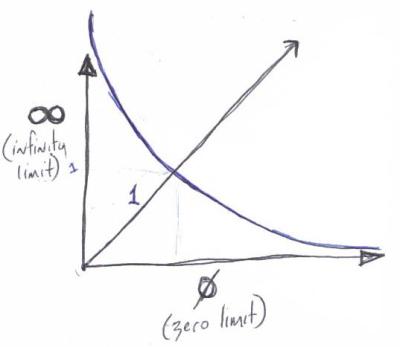
178.
The logic of the diagram is as follows. It is only zero, infinity, and one that are the stable “values” on the diagram. Any other value, when left to act upon itself, will trend toward either infinity or zero, never actually reaching their destination. This simple fact has been known since the time of Zeno and is well accepted. For example, 1.1 * 1.1 = 1.21, 1.21*1.21 = 1.4641, 1.4641 * 1.4641 = 2.14-something and were off to the races, headed toward the largest conceivable number + 1. On the other side of the dividing live the same and opposite trend emerges, 0.9 * 0.9 = 0.81, 0.81 * 0.81 = .06561 and the race is now headed the other direction, hurtling towards oblivion.
179.
What we are left with is a graph of the limits of all possible numbers, the exact midpoint of all possible numbers, and all possible numbers themselves. A good place to start when building a universal model, one would hope.
180.
The next step in understanding how math can lead to God is to loosen the reigns on the model and let it wander a bit. Normally we like to have graphs all nice and neat, flat and simple. Reality is far more chaotic than that. Reality tosses things every direction, exploring all possible angles. Our nice and balanced simplified model is now without direction, a ship without anchor. We have limits, sure, but we don’t know what they mean. And we don’t know where they are. As we shall see as we explore the implications of The Model™, how one defines the axes defines the context of the question/proposition. An answer without a question and a context is useless. A proposition with a without a fully defined context, including a temporal one, is not a well-formed proposition.
181.
To “illustrate” this concept, we first add the other side of the “0” line (the X axis) and add another “1”. Note how we now have a “negative” 0. This is possible because when we add the fourth dimension to the model we now have a way to discuss propositions in both the past and the future in the same manner [discussed further in Chapter 4].
182.
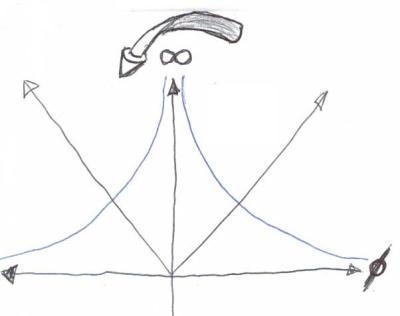
Extending the Model over Infinity
183.
We must also extend the graph over each of the “0” lines and extend the “∞” line, giving a full quadrant view. This gives us a “negative” ∞ to play with, which becomes very useful when discussing a timeline that is infinite in both directions.
184.
185.
186.
187. 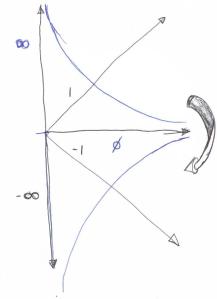
Extending the Model over Zero
188.
189.
190.
191.
192.
This is then extended to all quadrants and a “Z” axis (another set of “0”s) is added to give the full three dimensional form. The Blue lines in the following graph define the plane created by the addition of the “Z” axis.
193.
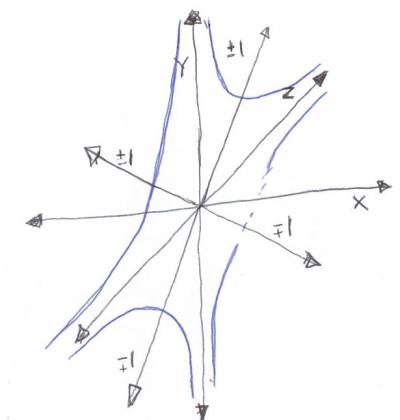
Adding the Z Axis
194.
Now we are beginning to see an ideal form begin to take shape, all built from a simple concept, and the applied to multiple dimensions. The ability to transfer relationships over each axis is allowed because of the symmetry of mathematics and reality. My reading of Emmy Noether’s work (perhaps the greatest female mathematician in modern history) says this is possible, accepted, and natural (which is to say, correct).
195.
Hence we are left with a three dimensional model that includes limits and relationships in all possible directions.
196.
What we don’t have, necessarily, is an exact direction in which each axis should point. As we factor in the chaos inherent in reality, and allow everything to spin around the origin, we are left with a “derivative” of the simple model. There is a part of reality that the model cannot touch.
197.
Translating pictures of three- dimensional objects on two-dimensional surfaces such as a page in a book requires a bit of work on your part, but I think you can manage.
198.
As we then recombine all the possible scenarios into a single image, and we get the following:
199.
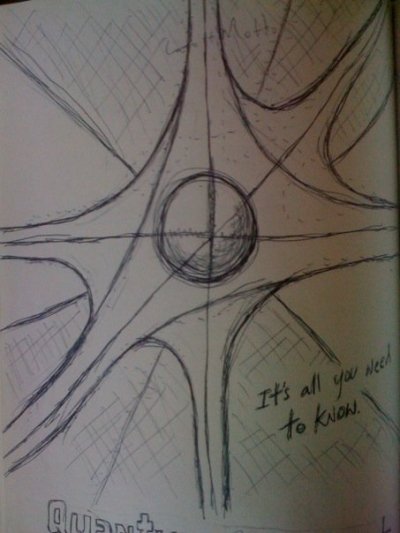
The Full Drawing (with a big error)
200.
This step is the final one to create a three-dimensional model (outside of time) and we finally see the fully realized (simple) model in its ideal form. Where once there were endless possibilities and numbers beyond imagining, now we have a simple something left over; a small piece of reality sitting in the middle untouched by the chaos of creation and possibility. What we have left is a sphere. A perfect, untouched sphere: The Gyroscope of Logic.
201.
Perhaps I should say what we have created through all the possible interactions and endless possibilities is a simple core that is, in fact, outside those possibilities. Or in this case, inside of them.
202.
It is this process of being both essential to the system yet outside of it that makes this model so wonderfully explanatory. It is both this aspect of the model, the simple logic of its creation, which adds to the massive amount of evidence that a sphere is a perfectly efficient shape. And in this case, I am using “massive” literally, as the vast majority of matter we have observed in the Universe is spherical in shape.
203.
So now we have a sphere, and an origin, and yet no defining line. We need only one. Either infinity or zero will do.
204.
This is why we consider God to be the infinite line, the definer of reality, and a million other names spoken with reverence since time immemorial. Zero is death, the end of the line, and the ceasing of action. It too, defines reality for the living. Absolute zero, in the scientific sense, is the ceasing of all action of energy. Our species has not yet achieved this goal, and I consider it to be unattainable, much like traveling at the speed of light. We can get close to this lower limit of energy, and have done so and created something called the “Bose-Einstein Condensate” which is very useful for some cool science, but if there was no energy left in a system, there would be no matter, and no system. Hence, we now have the ability to brush against the lower limit of reality, in a very real sense. Yet we cannot cross it, for there is nothing on the other side to greet us.
205.
The metaphor between your personal reality (that’s you, the one reading this book) and this model is that the infinite line represents the perfect action. That line represents the perfect response to any given stimulus or situation. What Would God Do? That action is represented by the God Path, the infinite line.
206.
The zero line, on the other hand, is usually representative of the worst possible action you could take, and one that would immediately make it impossible to reach your goal (The God Path). We can do this with the simplified version of the model and simply ascribe the words “Good” and “Evil” to actions on either side of the dividing line. It is for this reason that all cultures find purposeless suicide to be an immoral and selfish act.
207.
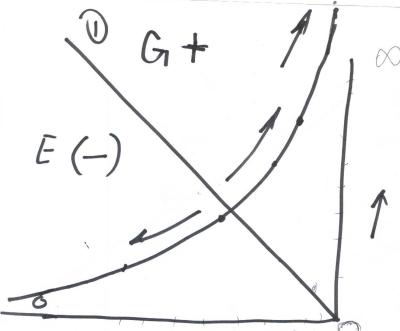
The Simple Moral Graph
208.
It would seem at first glance that this model would indicate there to be an equal amount of good and evil actions. However, as we will explore further in Chapter 6, once The Model is applied in four dimensions, the number of “good” actions becomes quite a bit smaller, as they become more similar and converge on the God Path, which is a single Infinite Line in a sea of Infinite Zeros (the plane created by the by the X and Z axes). Which is to say, there are many more wrong actions that right ones, as the right ones all begin to look like the same action.
209.
I would also like to point out that the sphere in the middle, defining the model, is you.
210.
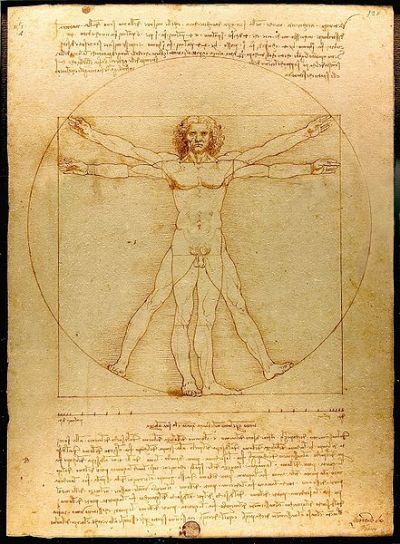
Vitruvian Man
211.
I would include a picture of a woman in the same sphere, but I don’t want to make this book too titillating for the younger (male) readers.
212.
The line with slope 1 in the model then becomes a neutral action, the procrastinator’s paradise, which would bring you no closer toward, yet no further from, your goal. “Purgatory”, which has some nice slopes in the real world [‽]. The Place of Purging. I will discuss this later as in my model of morality, it is always possible to respond to a negative action (defined as somewhere between 0 and 1) with an action of slope 1. What one is purging, in this sense, is the evil of the action of another.
213.
Understanding the metaphorical implications and abilities of the model requires intertwining the two concepts, stimulus (action) and response(reaction), with the three-dimensional model we’ve just created (the sphere, cognition, a “function” in math terms) to produce a functioning four-dimensional whole (The Model).
214.
This will be discussed further in Chapter 4: Adding the Fourth Dimension and Generalizing the Model.
215.
If you want to skip the emotional baggage I’ve carried on this journey of turning a simple equation into a worldview, and some of the reasons I’ve taken it this far, you can turn to Chapter 4 now, it begins on page [[xx]]. Chapter 3 deals with what happened to me to set me on this path. You will miss a great deal of exposition if you skip ahead, so choose your own adventure carefully.
216.
I most certainly have. Or perhaps I should say it has chosen me.
217.
218.
219.
220.
221.
222.
223.
224.
While writing this, I just remembered when this happened and it brings me to my knees in overwhelming joy. I’ll get into the brain and feelings and emotion and memory and perceived reality and feedback loops in a later chapter…but all I need to do, no matter how dark the current day might be, is remember the day I heard that, and I smile.
225.
226.
227.
228.
229.
230.
231.
232.
233.
234.
235.
236.
237.
238.
239.
240.
241.
242.
243.
244.
248.
249.
250.
468.
469.
470.
475.
476.
505.
506.